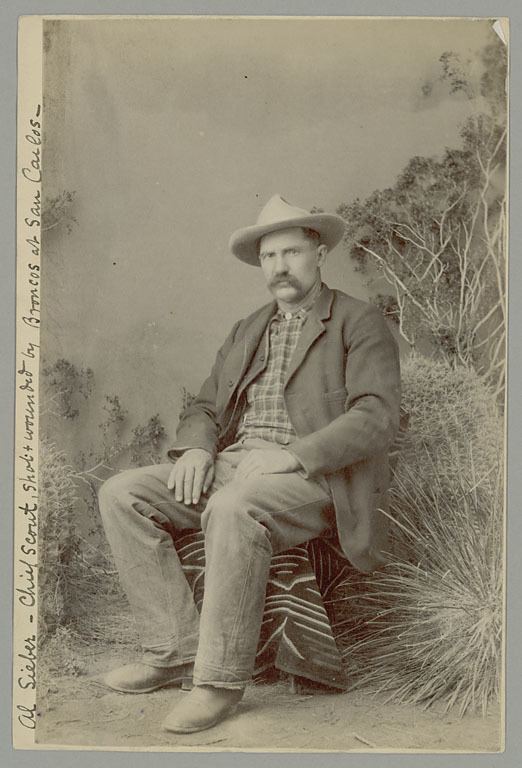Rank Chief of Scouts | Name Al Sieber | |
 | ||
Battles/wars Battle of AntietamBattle of FredericksburgBattle of ChancellorsvilleBattle of GettysburgApache WarsBattle of Cibecue CreekBattle of Big Dry Wash Similar People | ||
Years of service 1862-1864, 1871-1890 | ||
Chronicle of the old west al sieber
Al Sieber (February 27, 1843 – February 19, 1907) was a German-American who fought in the U.S Civil War and in the American Old West against Indians. He became a prospector and later served as a Chief of Scouts during the Apache Wars.
Contents
- Chronicle of the old west al sieber
- Al sieber
- Early life
- Civil War service
- Army scout and guide
- Wounds
- Post army life and death
- In film and media
- References
Al sieber
Early life
Albert "Al" Sieber was born in Mingolsheim, Baden as the 13th of 14 children. He was baptized on March 1, 1843, in St. Lambertus Church, Mingolsheim. His father Johannes died on September 16, 1845. Between March and April 1851, three years after the "Badian Revolution", his mother Eva Katharina née Fischer, immigrated with her still living eight children (six had already died) to Lancaster, Pennsylvania. The family moved to Minnesota several years later.
Civil War service
He enlisted on March 4, 1862, in Company B, 1st Minnesota Volunteer Infantry during the American Civil War. Sieber was severely wounded on July 2, 1863 in the Battle of Gettysburg, at Cemetery Ridge. He fought in several key engagements, including Battle of Antietam, Battle of Fredericksburg, Battle of Chancellorsville, Battle of Gettysburg, Apache Wars, Battle of Cibecue Creek, and Battle of Big Dry Wash. After the war, he became a prospector in California, Nevada, and in Arizona Territory, where he managed a ranch from 1868 to 1871.
Army scout and guide

In July 1871, General George Stoneman hired Sieber as Chief of Scouts and for much of the Apache Wars. He participated in Crook's Tonto (Apache) campaign (1871 – 1873). When the Camp Verde reservation was closed, Sieber was told to move Yavapais and Tonto Apaches to the San Carlos Reservation in the middle of winter. He remained employed there and participated in several engagements with Apache groups that had left the reservation.
On October 24, 1874, the Arizona Miner reported, “Al Zieber, Sergeant Stauffer and a mixed command of white and red soldiers are in the hills of Verde looking for some erring Apaches, whom they will be apt to find.” Three days later, Sieber and Sgt. Rudolph Stauffer found the Apaches that had escaped the reservation at Cave Creek and fought them. Josephine Earp wrote that when she arrived in Arizona, she learned that “some renegade Yuma-Apaches had escaped from the reservation to which they had been consigned and had returned to their old haunts on the war-path” and that Sieber was tracking the escaped Apache. She said Sieber and his scouts led her stagecoach and its passengers to a nearby adobe ranch house where they remained until the Indians were captured.
In February, April, and May 1877, Sieber acted as a guide for Pima County Marshal Wiley Standefer, who was pursuing outlaws in the region.
In 1883 Crook went into the Sierra Madre of Mexico following Geronimo. Sieber was Crook's lead civilian scout and mentor to Tom Horn, whom he taught to speak German, as well as fighting together during the Battle of Cibecue Creek and Big Dry Wash. Sieber was in the field but not present when Geronimo surrendered to Lt Charles B. Gatewood and General Nelson Miles in 1886.
Sieber stayed on at San Carlos as Chief of Scouts for another 13 years.
Wounds
In 1887, Sieber was shot and wounded when the Apache Kid and his followers escaped the reservation to prevent being jailed again. During his various battles and fights over the course of his life, Sieber received 28 wounds.
Post army life and death
Sieber was fired from his San Carlos Chief of Scouts position in December 1890 by Major John L. Bullis. He left San carlos and took up prospecting until 1898.
On February 19, 1907, Sieber was leading an Apache work crew that was building the Tonto road to the new Roosevelt Dam site on the [confluence of the Salt River and Tonto Creek on the border of Gila County and Maricopa County] in Gila County. The project was under the supervision of another famous frontier scout, "Yellowstone" Luther Kelly at Apache Trail, a separate downstream road, Maricopa County, Arizona. Sieber was killed when a boulder rolled on him during construction. He was buried with military honors at the cemetery in Globe, Arizona.
In film and media
Sieber has been portrayed in a number of films:
